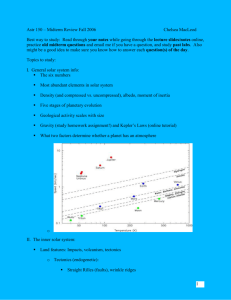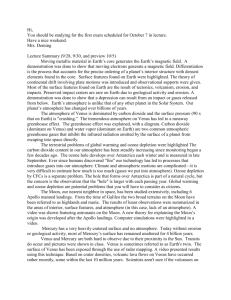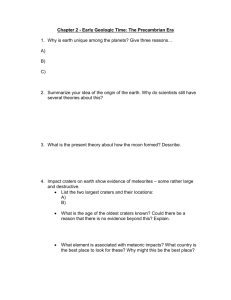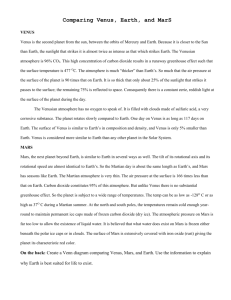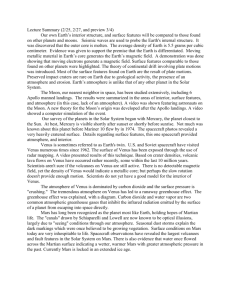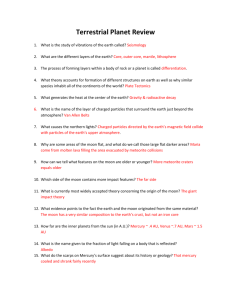Why is Earth geologically active?
advertisement
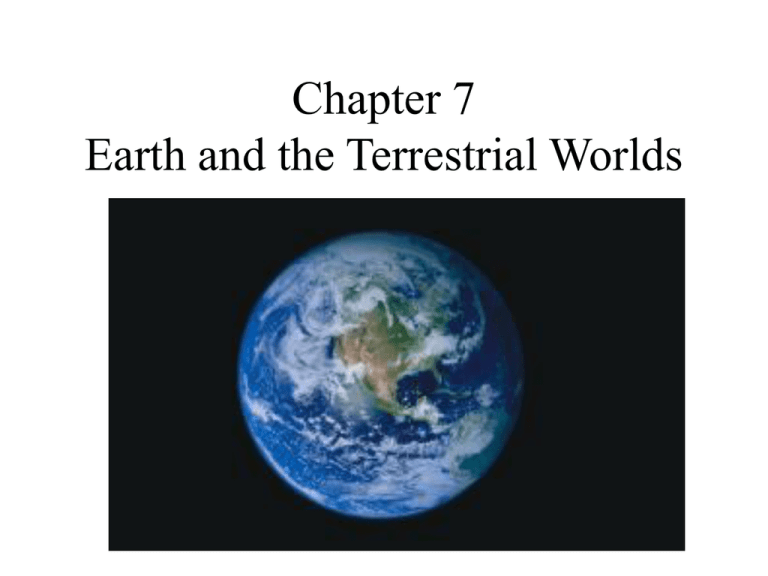
Chapter 7 Earth and the Terrestrial Worlds Mercury craters smooth plains, cliffs Venus volcanoes few craters Radar view of a twinpeaked volcano Mars some craters volcanoes riverbeds? Moon craters smooth plains Earth volcanoes craters mountains riverbeds Why have the planets turned out so differently, when they formed at the same time from the same materials? 7.1 Earth as a Planet Our Goals for Learning • Why is Earth geologically active? • What processes shape Earth’s surface? • How does Earth’s atmosphere affect the planet? Why is Earth geologically active? Why is Earth geologically active? Short answer: the Earth is big enough to still have a hot interior. So what do we know about the interior of the Earth and why is it hot? Internal Structure, by density Internal structure, by rock strength The “lithosphere” is the cool rigid rock that forms a planet’s outer layer: the crust and some of the mantle. The lithosphere floats on the lower layers. The thickness of the lithosphere controls many geological processes Internal Structure of the Terrestrial Planets Sources of Internal Heat 1) Gravitational potential energy of accreting planetesimals 2) Differentiation 3) Radioactivity Why do water and oil separate? A. Water molecules repel oil molecules electrically. B. Water is denser than oil, so oil floats on water. C. Oil is more slippery than water, so it slides to the surface of the water. D. Oil molecules are bigger than the spaces between water molecules. Why do water and oil separate? A. Water molecules repel oil molecules electrically. B. Water is denser than oil, so oil floats on water. C. Oil is more slippery than water, so it slides to the surface of the water. D. Oil molecules are bigger than the spaces between water molecules. Differentiation • Layers ordered by density • Highest density on the bottom • Gravity sorts materials by density. • Differentiation converts gravitational potential energy to heat. What cools off faster? A. A grande-size cup of Starbucks coffee B. A teaspoon of capuccino in the same cup. What cools off faster? A. A grande-size cup of Starbucks coffee B. A teaspoon of capuccino in the same cup. What cools off faster? A. A big terrestrial planet. B. A tiny terrestrial planet. What cools off faster? A. A big terrestrial planet. B. A tiny terrestrial planet. Why? What happens to Silly Putty if you pull it VERY SLOWLY? A. It stretches. B. It breaks. C. Nothing. What happens to Silly Putty if you pull it SHARPLY? A. It stretches. B. It breaks. C. Nothing. Do rocks s-t-r-e-t-c-h? A. No - rock is rigid and cannot deform without breaking. B. Yes - but only if it is molten rock. C. Yes - rock under strain may slowly deform. Do rocks s-t-r-e-t-c-h? A. No - rock is rigid and cannot deform without breaking. B. Yes - but only if it is molten rock. C. Yes - rock under strain may slowly deform. Heat Drives Geological Activity Convection: hot rock rises, cool rock falls. 1 cycle takes 100 million years on Earth. A large planet… • • • • Is still warm inside Has a convecting mantle Has a thinner, weaker lithosphere Has molten rock nearer the surface which makes it more geologically active Comparing the Planets Which planets have the most and least geological activity? Planetary magnetic fields Moving charged particles create magnetic fields. So can a planet’s interior, if the core it electrically conducting, convecting, and rotating Earth’s Magnetosphere Earth’s magnetic fields protects us from charged particles from the Sun The charged particles can create aurorae (“Northern lights”) If the planet core is cold, do you expect it to have magnetic fields? A. Yes, refrigerator magnets are cold, and they have magnetic field. B. No, planetary magnetic fields are generated by moving charges around, and if the core is cold, nothing is moving. If the planet core is cold, do you expect it to have magnetic fields? A. Yes, refrigerator magnets are cold, and they have magnetic field. B. No, planetary magnetic fields are generated by moving charges around, and if the core is cold, nothing is moving. How do we know what is inside the Earth? A. We can drill deep inside the Earth. B. We can use optical fibers to see deep inside the Earth. C. X-ray machines allow us to view the inside of the Earth. D. Seismic waves generated by earthquakes probe the Earth’s interior. How do we know what is inside the Earth? A. We can drill deep inside the Earth. B. We can use optical fibers to see deep inside the Earth. C. X-ray machines allow us to view the inside of the Earth. D. Seismic waves generated by earthquakes probe the Earth’s interior. What processes shape Earth’s surface? What processes shape Earth’s surface? 1) 2) 3) 4) Impact cratering Volcanism Tectonics Erosion Impact Cratering Impact Cratering • Moon must be hit as often as Earth. • Where are Earth’s craters? • Erased by volcanic activity and erosion. The more craters, the older the surface Volcanism Molten rock rises when it is: • Less dense than its surroundings. • Squeezed by its surroundings. • Pushed by expanding trapped gas (water vapor, CO2, N2, H2S, SO2) Volcanism • Erases other geological features • Provided gas for our atmosphere • Provided water for our oceans Why doesn’t Mars have as much volcanic activity as Earth? A. It’s too far from the Sun, so it cooled off faster. B. It’s smaller than the Earth, so it cooled off faster. C. It might, we just haven’t seen them erupt yet. Why doesn’t Mars have as much volcanic activity as Earth? A. It’s too far from the Sun, so it cooled off faster. B. It’s smaller than the Earth, so it cooled off faster. C. It might, we just haven’t seen them erupt yet. Tectonics and Plate Tectonics Tectonics: any surface reshaping from forces on the lithosphere Internal Heat Required! Plate tectonics: pieces of lithosphere moving around Only Earth has plate tectonics. Erosion • Wearing down or building up of geological features by wind, water and ice (weather) • Important on Earth - why? How does Earth’s atmosphere affect the planet ? How does Earth’s atmosphere affect Earth? 1) Erosion (already mentioned) 2) Protection from radiation 3) Changes the surface temperature: greenhouse effect 4) Makes the sky blue! Radiation Protection • All X-ray light absorbed very high in the atmosphere. • Ultraviolet light absorbed by ozone (O3) The Greenhouse Effect How does the greenhouse effect alter surface temperature? Earth’s atmosphere absorbs light at most wavelengths. Greenhouse effect: Certain molecules let sunlight through but trap escaping infrared photons (H2O, CO2, CH4) A Greenhouse Gas • Any gas that absorbs infrared • Greenhouse gas: molecules with 2 different types of elements (CO2, H2O, CH4) • Not a greenhouse gas: molecules with single or 2 atoms of the same element (O2, N2) Greenhouse Effect: Bad? The Earth is much warmer because of the greenhouse effect than it would be without an atmosphere…but so is Venus. What have we learned? • Why is Earth geologically active? • Internal heat drives geological activity, and Earth retains plenty of internal heat because of its relatively large size for a terrestrial world. This heat causes mantle convection and keeps Earth’s lithosphere thin, ensuring active surface geology. It also keeps part of Earth’s core melted, and the circulation of this molten metal creates Earth’s magnetic field. What have we learned? • What processes shape Earth’s surface? • The four major geological processes are impact cratering, volcanism, tectonics, and erosion. Earth has experienced many impacts, but most craters have been erased by other processes. We owe the existence of our atmosphere and oceans to volcanic outgassing. A special brand of tectonics— plate tectonics—shapes much of Earth’s surface. Ice, water, and wind drive rampant erosion on our planet. What have we learned? • How does Earth’s atmosphere affect the planet? • Two crucial effects are (1) protecting the surface from dangerous solar radiation— ultraviolet is absorbed by ozone and X rays are absorbed high in the atmosphere— and (2) the greenhouse effect, without which the surface temperature would be below freezing. 7.2 Mercury and the Moon: Geologically Dead • Our Goals for Learning • Was there ever geological activity on the Moon or Mercury? Was there ever geological activity on the Moon or Mercury? Moon • Some volcanic activity 3 billion years ago must have flooded lunar craters, creating lunar maria. • The Moon is now geologically dead. Mercury • Plenty of craters - including a huge ‘basin’ • Smooth plains from volcanism (recent or long ago???) Did Mercury shrink? Steep long cliffs formed when the core cooled, shrinking the planet by ~20 km. Mercury is now geologically dead. What have we learned? • Was there ever geological activity on the Moon or Mercury? • Both the Moon and Mercury had some volcanism and tectonics when they were young. However, because of their small sizes, their interiors long ago cooled too much for ongoing geological activity. 7.3 Mars: A Victim of Planetary Freeze-drying • Our Goals for Learning • What geological features tell us that water once flowed on Mars? • Why did Mars change? Mars vs. Earth • • • • • 50% Earth’s radius, 10% Earth’s mass 1.5 A.U from the Sun Axis tilt about the same as Earth. Similar rotation period. Orbit is more elliptical than Earth’s: seasons more extreme in the south than the north. • Thin CO2 atmosphere: little greenhouse Main Difference seems to be: Mars is SMALLER! What geological features tell us water once flowed on Mars? Surface of Mars appears to have ancient river beds Eroded crater Condition of craters indicates surface history Closeup of eroded crater Volcanoes…as recent as 180 million years ago… Past tectonic activity… Low-lying regions may once have had oceans Low-lying regions may once have had oceans Opportunity Spirit • 2004 Opportunity Rover provided strong evidence for abundant liquid water on Mars in the distant past. •How could Mars have been warmer and wetter in the past? Today, most water lies frozen underground (blue regions)… Some scientists believe accumulated snowpack melts to carve gullies even today Why did Mars change? Would “terraforming” Mars work? • Yes • No What have we learned? • What geological features tell us that water once flowed on Mars? • Dry river channels, rockstrewn floodplains, and eroded craters all show that water once flowed on Mars, though any periods of rainfall seem to have ended at least 3 billion years ago. Mars today still has water ice underground and in its polar caps, and could possibly have pockets of underground liquid water. What have we learned? • Why did Mars change? Mars’s atmosphere must once have been much thicker with a much stronger greenhouse effect, so change must have occurred due to loss of atmospheric gas. Much of the lost gas probably was stripped away by the solar wind, which was able to reach the atmosphere as Mars cooled and lost its magnetic field and protective magnetosphere. Water was probably also lost because ultraviolet light could break apart water molecules in the atmosphere, and the lightweight hydrogen then escaped to space. 7.4 Venus: A Hothouse World • Our Goals for Learning • Is Venus geologically active? • Why is Venus so hot? Is Venus geologically active? Is Venus geologically active? Radar images show lots of volcanic & tectonic features, as expected for a large terrestrial planet Why is Venus so hot? Greenhouse effect. But why is it so prominent on Venus? Thick CO2 atmosphere of Venus locks heat in Where is Earth’s CO2? Where is Earth’s CO2? Rocks - like limestone (and some in plant life and in the ocean) Why did this happen on Earth and not on Venus? Venus lacks oceans to dissolve the carbon dioxide and lock it away in rock on the seafloor And why is that? We can understand Venus’ history by thinking about what would happen if Earth were moved to Venus’ orbit. How would the initial heating affect the oceans and the greenhouse effect? A runaway greenhouse effect would then occur. Eventually, water molecules would break down & escape to space, just as apparently happened on Venus What have we learned? • Is Venus geologically active? • Venus almost certainly remains geologically active today. Its surface shows evidence of major volcanic or tectonic activity in the past billion years, and it should retain nearly as much internal heat as Earth. However, geological activity on Venus differs from that on Earth in at least two key ways: lack of erosion and lack of plate tectonics. • Why is Venus so hot? • Venus’s extreme surface heat is a result of its thick, carbon dioxide atmosphere, which creates a very strong greenhouse effect. The reason Venus has such a thick atmosphere is its distance from the Sun: It was too close to develop liquid oceans like those on Earth, where most of the outgassed carbon dioxide dissolved in water and became locked away in rock. Thus, the carbon dioxide remained in the atmosphere, creating the 7.5 Earth as a Living Planet • Our Goals for Learning • What unique features on Earth are important for human life? • How might human activity change our planet? • What makes a planet habitable? What unique features of Earth are important for life? 1) 2) 3) 4) Surface liquid water Atmospheric oxygen Plate tectonics Climate stability What unique features of Earth are important to human life? 1) 2) 3) 4) Surface liquid water Atmospheric oxygen Plate tectonics Climate stability Earth’s distance from the Sun and moderate greenhouse effect make liquid water possible What unique features of Earth are important to human life? 1) 2) 3) 4) Surface liquid water Atmospheric oxygen Plate tectonics Climate stability PHOTOSYNTHESIS (plant life) is required to make high concentrations of O2, which produces the protective layer of O3. What unique features of Earth are important to human life? 1) 2) 3) 4) Surface liquid water Atmospheric oxygen Plate tectonics Climate stability Plate tectonics are an important step in the carbon dioxide cycle. The Carbon Dioxide Cycle What unique features of Earth are important to human life? 1) 2) 3) 4) Surface liquid water Atmospheric oxygen Plate tectonics Climate stability The CO2 cycle acts like a thermostat for the Earth’s temperature. These unique features are intertwined: • plate tectonics creates climate stability • climate stability allows liquid water • liquid water is necessary for life • life is necessary for atmospheric oxygen How many other connections between these can you think of? How might human activity affect Earth’s climate? Earth’s ice ages end as oceans freeze over and volcanoes release CO2 into the atmosphere Human activity is increasing the concentration of greenhouse gases in the atmosphere, which may strengthen the greenhouse effect and lead to global warming. What makes a planet habitable? • Located at an optimal distance from the Sun for liquid water to exist. What makes a planet habitable? • Large enough for geological activity to release & retain water and atmosphere. Planetary Destiny Earth is habitable because it is large enough to remain geologically active and at the right distance from the Sun so oceans could form. What have we learned? • What unique features of Earth are important for life? • Unique features of Earth on which we depend for survival are • (1) surface liquid water, made possible by Earth’s moderate temperature; • (2) atmospheric oxygen, a product of photosynthetic life; • (3) plate tectonics, driven by internal heat; and • (4) climate stability, a result of the carbon dioxide cycle, which in turn requires plate tectonics. What have we learned? • How might human activity change our planet? • Ozone depletion can leave surface life more vulnerable to dangerous solar ultraviolet radiation, and the high rate of extinctions could have unknown consequences. The human release of greenhouse gases into the atmosphere may already be causing global warming and What have we learned? • What makes a planet habitable? • We can trace Earth’s habitability to its relatively large size and its distance from the Sun. – Its size keeps the internal heat that allowed volcanic outgassing to lead to our oceans and atmosphere, and also drives the plate tectonics that helps to regulate our climate through the carbon dioxide cycle. – Its distance from the Sun is neither too close nor too far, thereby allowing liquid water to exist on Earth’s surface.
